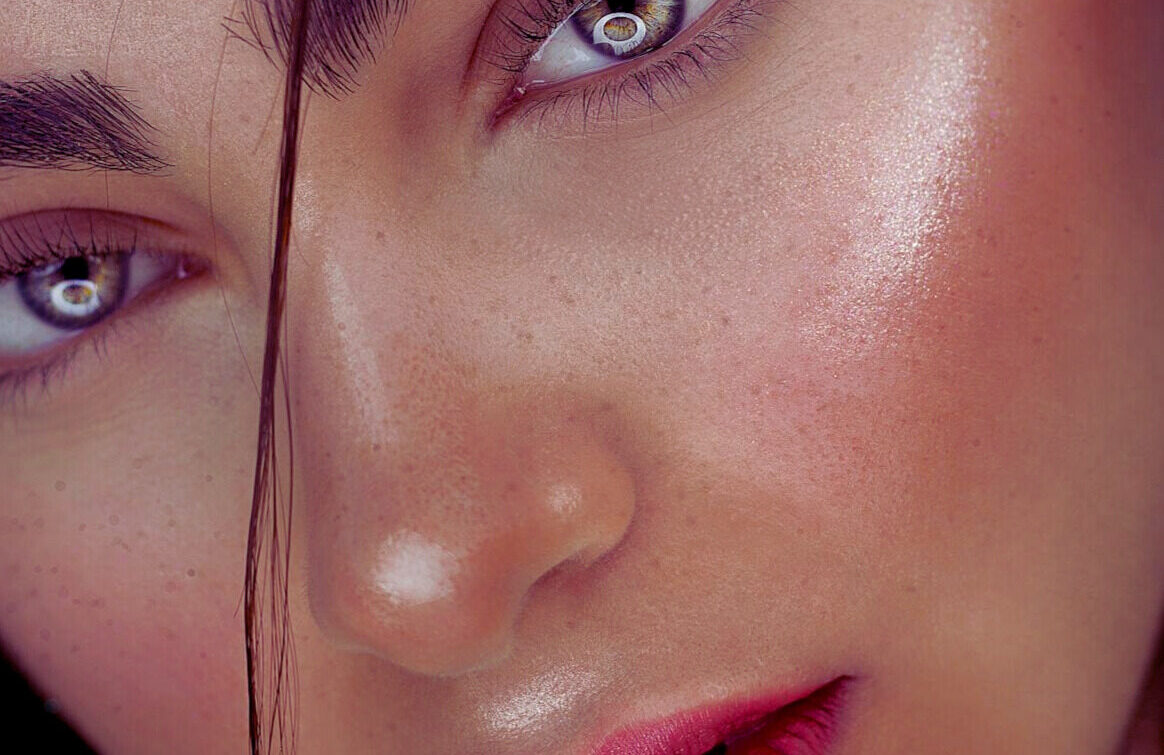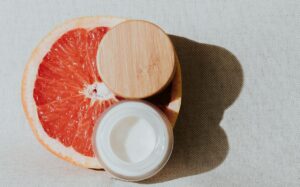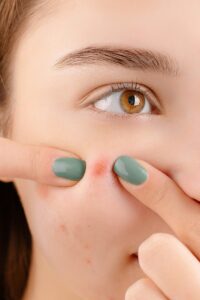If your face turns into a glazed donut by noon (and not the cute Hailey Bieber kind), I welcome to the oily skin club. I know it’s super annoying. It’s the kinda gift that keeps on giving, talk about all the extra shine, clogged pores, and the never-ending surprise breakouts. But don’t worry, this complete guide to oily skin will help you understand what’s going on and how to keep your skin balanced (without waging war on your sebaceous glands).
But before you all oily skin folks go scrubbing your face raw or swearing off moisturizer forever (which is a bad idea), let’s talk. Oily skin isn’t the enemy here, it just needs the right routine. That’s exactly what this guide to oily skin is all about, packed with some real skincare tips, myth-busting facts, and a routine that actually works.
Your skin isn’t just being dramatic. It has a reason for all that oiliness, and once you understand why, controlling it becomes a whole lot easier. So, let’s get into it, minus the bad advice and overly complicated routines, I promise.
Why does oily skin produce more oil?
There’s a reason your skin is extra shiny, especially in the T-zone area (forehead, nose, and chin). The real culprit is sebum. Sebum is the natural oil your skin produces to keep things going well. While it’s great in its usual normal amount, it keeps your skin barrier strong and even helps prevent premature wrinkles. (Yes, oily skin ages slower—tiny win?)
But when your sebaceous glands decide to go into oil overdrive, which happens with oily skin types, things get a little messy. Excess oil = clogged pores. And clogged pores? Well, you already know the drill. You get blackheads, whiteheads, and full-blown breakouts. That midday grease slick isn’t just annoying, it’s basically an open invitation for acne to move in rent-free on your face.
But other than that, hormones, even the weather (hot, humid days are the worst) can make your skin produce more oil. And if you’re out here scrubbing your face or skipping moisturizer (big mistake), your skin might actually freak out and produce even more oil to compensate (classic overcompensation move).
Oily Skin Myths You Need to Stop Believing
There’s a lot of bad advice from the depths of internet out there about oily skin. From over-washing your face to skipping moisturizer (gasp!), some of these myths are actually making your skin more oily. Let’s bust some myths here.
Myth #1: You need to dry out your skin to control oil
Reality: Stripping your skin with either cleansers or toners makes it produce even more oil, like a clingy ex who just won’t take a hint. When you over-wash or use harsh products (looking at you, alcohol-heavy toners), your skin panics and pumps out even more oil to compensate. As already mentioned, the result is a vicious cycle of dryness → oiliness → breakouts.
Instead, use a gentle, oil-controlling cleanser, and for toner, go for hydrating, oil-balancing options with niacinamide, green tea extract, or witch hazel. They help regulate sebum without messing up your skin barrier. The goal isn’t to eliminate oil completely, it’s to get rid of excess oil while keeping the natural amount your skin needs to stay healthy.
Myth #2: Oily skin doesn’t need moisturizer or less moisturizer
Reality: Oh, but it does! Just because your skin is oily doesn’t mean it’s well hydrated. In fact, skipping moisturizer can trick your skin into producing more oil to make up for the lack of hydration. The key is to use lightweight, oil-free, gel-based moisturizers. Think hydration, not suffocation. Look for ingredients like hyaluronic acid and niacinamide, they give your skin the moisture it needs without turning it into an oil slick.
Myth #3: Oily skin is just a teenage problem.
Reality: If only! Oily skin is not just a phase that you only experience in your teenage. It is influenced by other factors as well, such as genetics, hormones, stress, and even weather. That’s why some people still deal with shine well into adulthood. But adulting your skincare routine with the right ingredients (hello, salicylic acid, lactic acid and niacinamide!) can keep oil in check at any age.
Myth #4: Blotting papers will fix oily skin
Reality: Blotting papers are great for a quick touch-up, but they’re like putting a bucket under a leaky ceiling, it doesn’t fix the root issue. Overusing them can even trick your skin into producing more oil (because of course, it would). Instead, focus on a skincare routine that balances oil, so you’re not blotting every five minutes like you don’t have anything else to do.
Best Skincare Ingredients for Oily Skin
A good skincare routine keeps your oil in check without turning your skin into a desert. Think gentle cleansing, lightweight hydration, and oil-balancing ingredients without stripping your face like it owes you money.
- Cleanser → A gentle foaming or gel cleanser is what you need. A mild lather is good for oily skin. Use one that removes oil, not your will to live.
- Toner → Niacinamide, green tea extract, lactic acid or salicylic acid, is your BFF. It clears pores and tells your oil glands to chill.
- Moisturizer → Yes, even oily skin needs moisture. Go for something lightweight (avoid ones with emollients)—think hydration, not suffocation.
- SPF → Because sun damage triggers even more oil.
Skincare Ingredients Oily Skin Should Avoid (And Better Alternatives!)
If you have oily skin, you need to steer clear of ingredients that clog pores, over-strip moisture, or make oil production worse.
The big offenders are:
Alcohol-based toners – they give that squeaky clean feel at first but actually strip your skin, making it overcompensate with even more oil (plot twist: oil control backfires).
Coconut oil & Shea butter – while they are amazing for dry skin, but a nightmare for oily skin. These are comedogenic, meaning they’re likely to trap oil and bacteria, leading to breakouts.
Heavy silicones (like dimethicone in excess) – while silicones can give that smooth, velvety feel, too much of them can trap oil and debris under the skin, leading to congestion.
Fragrances & Essential Oils (in excess) – citrus oils, peppermint, and lavender can irritate the skin, leading to more oil production (yes, your skin fights back).
Occlusive-heavy moisturizers (like petrolatum or mineral oil) – these create a heavy barrier that locks in oil and sweat and turn your face into a breeding ground for breakouts.
Better Alternatives for Oily Skin
- Niacinamide or Witch Hazel
- Squalane or Jojoba Oil
- Water-based or Gel Moisturizers
- Fragrance-free or Hypoallergenic Products
- Gel-based or Oil-free Moisturizers
Final thought
Oily skin isn’t the enemy here, it just needs the right routine. Balance, not war. Ditch the harsh, stripping products and load up on oil-balancing MVPs like niacinamide, salicylic acid, AHAs, and lightweight hydration. Avoid heavy, pore-clogging ingredients, that includes chemical sunscreens that can make oily skin feel even greasier.
Blotting papers? Great for a quick fix, but they’re not a long-term solution (your skin needs real balance, not a temporary oil mop). Try a clay mask once a week to keep excess oil in check, and don’t sleep on the little things—like regularly cleaning your makeup brushes.
Small habits, big impact. Treat your skin right, and your glow will be the healthy kind, not the “walking disco ball by noon” kind.
How Oily Is Your Skin? Take This Highly Scientific (not really) Quiz!
A) Slightly dewy? You get a little T-zone shine but there is nothing major. You could go a full day without blotting.
B) T-zone trouble? Your forehead and nose start getting suspiciously reflective by noon, and blotting papers are your ride-or-die.
C) Frying an egg on your forehead by noon? Your skin produces enough oil to power a small village. You start the day fresh, but by 3 PM, it’s full-on disco ball mode.
If you answered mostly A, your skin is on the balanced side, lucky you! Mostly B? You’re classic combination-to-oily, and keeping your T-zone in check is the goal. Mostly C? You, my friend, have true oily skin. But don’t worry, we’ve got the ultimate guide to keep that glow under control (the right way).
Maleeka is an orthodontic resident with a passion for skincare and beauty. She decodes beauty products, breaks down ingredients, and spills the tea on marketing hypes. When she’s not perfecting smiles or geeking out over the latest formulations and trends, you’ll find her binge-watching Netflix.





Pingback: Why Cetaphil Oily Skin Cleanser Might Not Be For Everyone
Pingback: What Does Body Oil Do For Your Skin & Do You Really Need One?
Pingback: 8 Best Fungal Acne Safe Moisturizers
Pingback: How To Use Lactic Acid In Your Skincare Routine
Pingback: I Had A Damaged Skin Barrier & Here’s How The Ordinary Moisturizer Helped
Pingback: Best Korean Skincare Routine For Acne Prone Skin